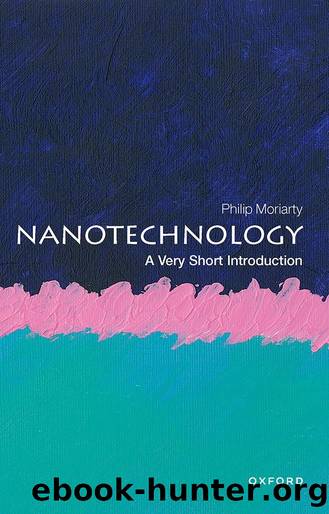Nanotechnology by Philip Moriarty

Author:Philip Moriarty [Moriarty, Philip]
Language: eng
Format: epub
ISBN: 9780192577900
Publisher: OUP Oxford
Published: 2022-11-15T00:00:00+00:00
Breaking down the barriers: tunnelling electrons
Transistors are essentially a three-terminal switch that, in CMOS architecture, comprises a source, a drain, and a gate electrode. By applying a voltage to the gate electrode the flow of electronsâthat is the electric currentâbetween the source and drain can be switched on or off, placing the transistor in a â0â or â1â state. This is the basis of the binary logic that drives so much of our technology. When the gate length is at the micron, hundreds of nanometre, or even tens of nanometre length scale, the transistor can be controllably, and rapidly, switched on and off. We are, in effect, in the classical limitâthe quantum nature of electrons does not have a huge influence on device operation.
Shrinking the gate length to sub-10 nm dimensions, however, changes the nanoscale physics of the situation dramatically. On these scales, quantum mechanical tunnellingâexactly the same tunnelling effect that is exploited in the scanning tunnelling microscopeâbecomes of key importance and can dominate the operation of the transistor. Electrons no longer âseeâ the barrier presented by the insulating silicon oxide. Instead, they tunnel straight through it because their wavefunction penetrates the barrier and, in essence, shorts out the oxide between the source and the drain. This creates a leakage current and makes the transistor exceptionally unreliable because even in its nominal âoffâ state, there can still be spontaneous current flow due to tunnelling.
A key aspect of tunnelling is that the process is extremely sensitive to the barrier widthâitâs this sensitivity that lends the STM its exceptionally high resolution (because very small changes in tip-sample separation lead to very large changes in the measured tunnel current). But whatâs a boon for the STM is a bane for CMOS nanoelectronics: as feature size gets smaller and smaller, the probability of electrons tunnelling through the oxide goes up exponentially. Each time the barrier width reduces by the diameter of just one atom, the tunnelling probability increases by a factor of hundreds. Although current research is focused on what are called high k dielectricsâreplacements for silicon oxide that have insulating properties selected to provide less penetrable barriersâin many ways this is simply postponing the inevitable. Mooreâs law canât continue indefinitely because quantum tunnelling is ultimately going to short out the devices.
If we canât engineer around quantum physics, why donât we just embrace it instead? This is exactly the principle at the core of a quantum computer, in which the wavelike characteristics of matter, including tunnelling, form the basis of an entirely new approach to computing and device technology. However, and contrary to the more excitable pundits and predictions out there, quantum computing is not going to completely replace conventional computer technology. Sure, a quantum computer can solve problems and run algorithms that a classical computer would find impossible, or that would take an impossibly long time to complete (millions or billions of years). But the converse is equally true: classical computers are already better than their potential quantum counterparts at very many tasks,
Download
This site does not store any files on its server. We only index and link to content provided by other sites. Please contact the content providers to delete copyright contents if any and email us, we'll remove relevant links or contents immediately.
Learning SQL by Alan Beaulieu(6212)
Weapons of Math Destruction by Cathy O'Neil(6148)
Digital Minimalism by Cal Newport;(5667)
iGen by Jean M. Twenge(5367)
Sapiens by Yuval Noah Harari(5294)
The Age of Surveillance Capitalism by Shoshana Zuboff(4214)
Elon Musk by Ashlee Vance(4032)
Thing Explainer by Randall Munroe(3877)
Apollo 8 by Jeffrey Kluger(3637)
Future Crimes by Marc Goodman(3534)
The Science Book (Big Ideas Simply Explained) by DK(3233)
Who Can You Trust? by Rachel Botsman(3089)
Infinite Energy Technologies by Finley Eversole(2939)
I Live in the Future & Here's How It Works by Nick Bilton(2938)
The Innovators: How a Group of Hackers, Geniuses, and Geeks Created the Digital Revolution by Walter Isaacson(2849)
Steve Jobs by Walter Isaacson(2837)
Dawn of the New Everything by Jaron Lanier(2738)
Chernobyl by Serhii Plokhy(2497)
Ben Franklin's Almanac by Candace Fleming(2470)
